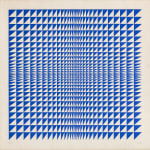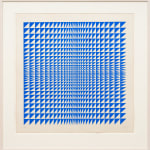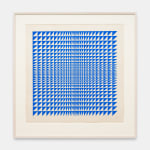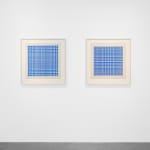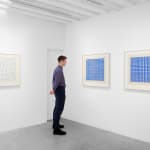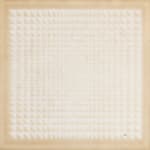Luiz Sacilotto Brazilian, 1924-2003
GUA 0244, 1979
Gouache on paper
66 x 66 cm
26 x 26 in
26 x 26 in
Further images
Luiz Sacilotto (1924 - 2003), originally one of the innovators of Brazilian Concrete art (abstract art that is entirely free of observed reality and that has no symbolic meaning), was...
Luiz Sacilotto (1924 - 2003), originally one of the innovators of Brazilian Concrete art (abstract art that is entirely free of observed reality and that has no symbolic meaning), was described by Waldemar Cordeiro, leader of the ‘Ruptura’ group, as the ‘structural beam’ of Concretism in Brazil. Augusto de Campos, concrete poet, writer, and friend of Sacilotto, also identifies his work in the 1950s as a precursor to Op-Art, claiming that the Brazilian was experimenting with this art form before even Victor Vasarely, who is widely recognised as the father of the movement.
In the wake of a military coup in 1964, which marked the beginning of the civil-military dictatorial regime which lasted 21 years, Sacilotto took a ten year hiatus from his practice as an artist. This was in part due to the political situation but Denise Mattar suggests that this career interval was prompted primarily by the end of concretism’s utopian phase. After this intermission, Sacilotto returned to the studio with renewed vigour and with a desire to make his work less static and to focus even more on the kinetic, ‘Op’ elements of his painting. This pair of works, both entitled Study (1979), is demonstrative of the wealth of experience and skill that Sacilotto had amassed at this stage of his artistic career. They highlights his geometric precision, manual dexterity, and ability to conjure up illusory, optical effects; furthermore, they represent a turning point for the artist in terms of his use of colour. Despite having always included colour in his works, this moment prefaces Sacilotto’s turn, in the 1980s, towards his meticulous, almost obsessive, studies of colour. His studio contained a large assortment of labelled pigments from over the world, as well as detailed colour charts pertaining to manufacturers or to local areas where he collected natural pigments.
These gouache paintings are a prime example of Sacilotto’s mastery of Op-Art; both are composed of 31 blue, right-angled triangles running vertically and horizontally (961 in total). In both works, the triangles are stretched and squashed to craft a vibratory, optical effect. The two works are opposites: in one the triangles become larger towards the centre of the work which creates the illusion of a sphere; in the other they become smaller, which gives the effect of a cross dissecting the composition. These paintings demonstrate Sacilotto’s exactitude and perfection, not as technical precision for its own sake, but rather as a tool to stimulate an experience in the viewer’s subconscious.
In the wake of a military coup in 1964, which marked the beginning of the civil-military dictatorial regime which lasted 21 years, Sacilotto took a ten year hiatus from his practice as an artist. This was in part due to the political situation but Denise Mattar suggests that this career interval was prompted primarily by the end of concretism’s utopian phase. After this intermission, Sacilotto returned to the studio with renewed vigour and with a desire to make his work less static and to focus even more on the kinetic, ‘Op’ elements of his painting. This pair of works, both entitled Study (1979), is demonstrative of the wealth of experience and skill that Sacilotto had amassed at this stage of his artistic career. They highlights his geometric precision, manual dexterity, and ability to conjure up illusory, optical effects; furthermore, they represent a turning point for the artist in terms of his use of colour. Despite having always included colour in his works, this moment prefaces Sacilotto’s turn, in the 1980s, towards his meticulous, almost obsessive, studies of colour. His studio contained a large assortment of labelled pigments from over the world, as well as detailed colour charts pertaining to manufacturers or to local areas where he collected natural pigments.
These gouache paintings are a prime example of Sacilotto’s mastery of Op-Art; both are composed of 31 blue, right-angled triangles running vertically and horizontally (961 in total). In both works, the triangles are stretched and squashed to craft a vibratory, optical effect. The two works are opposites: in one the triangles become larger towards the centre of the work which creates the illusion of a sphere; in the other they become smaller, which gives the effect of a cross dissecting the composition. These paintings demonstrate Sacilotto’s exactitude and perfection, not as technical precision for its own sake, but rather as a tool to stimulate an experience in the viewer’s subconscious.
Provenance
Artist’s Family Estate
Private collection, São Paulo
Publications
Sacilotto. Denise Mattar, Gabriel Pérez-Barreiro, published by Cosacnaify, Sao Paulo, 2021. Illustrated pg. 819
of
9






